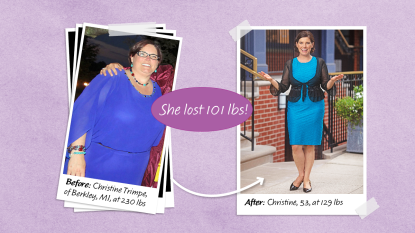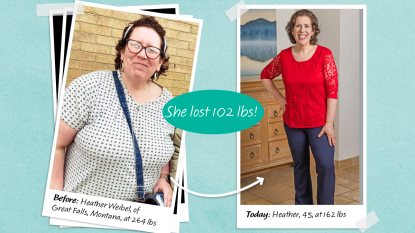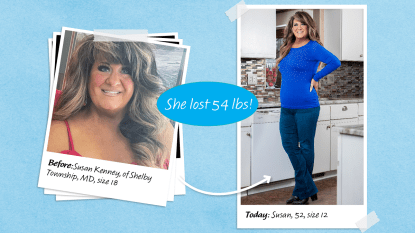Alternate-Day Fasting May Help You Bust That Gut — And Can Even Reverse Type 2 Diabetes, Experts Say

If you want to lose weight but find dieting every day to be too restrictive, you might consider alternate-day fasting as a possible option. A form of intermittent fasting that calls for you to routinely switch between fasting days and “feasting days” each week, alternate-day fasting has become a popular option for folks who don’t want to restrict calories every single day or give up entire food groups. This type of fasting can actually work for your weight loss and health goals — if the diet is right for you.
What is alternate-day fasting?
Alternate-day fasting involves fasting one day, feasting the next day, and then repeating for the whole time period that you’re on the diet. Let’s address the fasting days first: You do get to eat on these days, but your calories are quite restricted. The recommended amount of calories for fasting days is 25 percent of the calories that are recommended for a daily diet. So let’s say hypothetically that you were instructed to consume 1,900 calories per day to lose weight. Your calorie count for your fasting days would be 475. Alternate-day fasting proponents suggest no more than 500 calories on those days for folks following that diet.
As for the feasting days, the alternate-day fasting diet can allow for up to 125 percent of those daily recommended calories for weight loss. So keeping in line with the hypothetical 1,900-calorie count, the fasting days would allow you to eat 2,375 calories on the feasting days.
Is alternate-day fasting right for you?
Alternate-day fasting may have the most impressive benefits for people with type 2 diabetes, according to the latest research. A 2018 paper, published in BMJ Case Reports, suggested that this practice might even help some patients reverse type 2 diabetes. Doctors explained that three patients with the condition were able to cut out their need for insulin treatment while fasting for 10 months. Two of those patients fasted on alternate days for a full 24 hours, and the third fasted for three days per week. On the patients’ fasting days, they only consumed low-cal drinks throughout the day, such as tea, coffee, water, or broth, and then, one low-cal meal in the evening.
As it turned out, all three patients were able to stop insulin treatments within just a month of fasting. Additionally, they all lost weight and reduced their average blood sugar readings, which could possibly help lower the risk of future complications. “The use of a therapeutic fasting regimen for treatment of [type 2 diabetes] is virtually unheard of,” said the researchers in a press release. “This present case series showed that 24-hour fasting regimens can significantly reverse or eliminate the need for diabetic medication.”
But don’t think that folks with type 2 diabetes are the only ones who can reap the weight-loss benefits of alternate-day fasting. A 2017 study, published in JAMA Internal Medicine, found that alternate-day fasting can also be a substitute to daily calorie restriction for metabolically healthy obese adults, suggesting there is no significant difference between the two in terms of how much weight you can lose — which is a darn good amount.
In an interview with CNN, lead author Krista Varady, PhD, said: “We basically showed that they both produce a clinically significant amount of weight loss. Instead of being better than calorie restriction, it’s the same,” she said of alternate-day fasting. “So it’s kind of like an alternative to calorie restriction.”
Even though there may not be much of a difference in terms of how many pounds you shed, a 2016 review of 28 studies found that alternate-day fasting did yield greater fat-mass loss for participants on that plan than for those following the traditional daily calorie restriction. In response, researchers said that the alternate-day fasting might be superior to daily calorie restriction for some patients due to the greater fat-mass loss. They added that it might be easier to follow for people who don’t want to restrict their calorie intake every day.
That said, it’s worth mentioning that some people find it much easier to restrict calories day by day, rather than every other day. For instance, the JAMA study saw a much higher dropout rate of those following the alternate-day fasting diet than the folks following the traditional weight-loss method — as well as a higher rate of alternate-day fasters cheating on their diet.
All in all: Some people’s lifestyles and everyday habits might not allow for such a strict schedule each week, especially when it comes to family traditions of eating together or other social occasions of eating out with loved ones. But for others, it may be just what they need to keep them on track. Remember, always get your doctor’s OK before starting any new diet.
Next, learn about the tastiest superfoods that can help you live longer in the video below:
More From FIRST
6 Foods That’ll Give You a Calcium Fix When You’re Looking to Skip the Milk
5 Things You Need to Know About Slow Cookers From Chefs Who Use Them Every Day
The Best Way to Reheat Rotisserie Chicken so It’s as Delicious as the Day You Bought It













